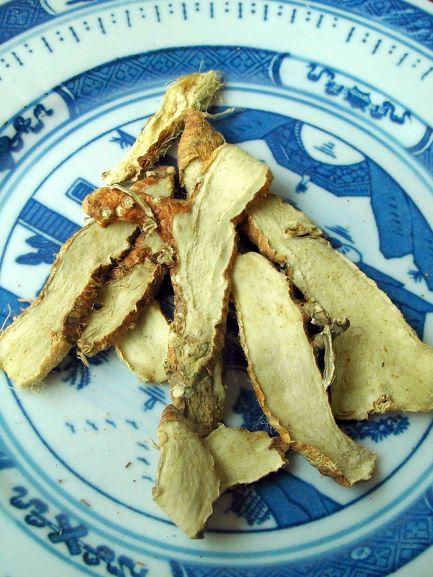Name
Latin Name: Rhizoma AnemarrhenaeCommon Name: Anemarrhena rhizome Scientific Name: Anemarrhena asphodeloides Bge.
Chinese Name: 知母Pinyin Name: zhi mu
Origin
Anemarrhena rhizome is the dried tuber of Anemarrhena asphodeloides Bge., a plant of the Liliaceae family.1
Where Does It Grow?
Anemarrhena rhizome is mainly produced in Hebei and Shanxi provinces of China; other like Inner Mongolia, Henan, Shanxi, Gansu and the northeast China are also produced. Nowadays, the herb is cultivated all over China. 1
Nature and Flavor
Anemarrhena rhizome is cold in nature, sweet and bitter in flavor, and mainly manifests its therapeutic actions in the lung, stomach and kidney meridian.
2.6
Identified Active Components / Major Chemical Constituents
Anemarrhena rhizome contains a wide range of saponins, such as timosaponins AIII, B, BI-VI,C1-C2,D,D1-D2,E1,F-G,H1-H2,I1-I2, marcogenin, xilingsaponins A-B, sarsasapogenin, smilageninoside, amemarsaponins A1, A2, B-C, E-G, and anemarrhenasaponins I-IV, Ia. It also contains polysaccharides such as anemarans A-D; flavonoids such as baohuaside-I, icariside-I, mangiferin, and neomangiferin; lignin types such as cis-hinokiresinol, monomethyl-cis-hinokiresinol, and oxy-cis-himokiresinol; others areβ-sitosterol, alkaloid, choline, tannic acid, nicotinamide, nicotinic acid, pantothenic acid, minimals and rich mucoid substances.4,5,6,7
In the Pharmacopoeia of People's Republic of China (2015 Edition) - Part I, the level of timosaponin BII should not less than 3.0%, and the level of mangiferin should not less than 0.50%, as the standard quality of the herb.

Drug Actions in TCM
Anemarrhena rhizome clears heat, purges fire, nourishes yin and moistens dryness.2
Traditional Uses in TCM
Anemarrhena rhizome is often used for infectious conditions, high fever with extreme thirst, coughing due to lung heat, hot flush, diabetes and constipation.2,3
Anemarrhena rhizome clears heat and purges fire
Anemarrhena rhizome specializes in clearing heat in the lungs and stomach. Infectious conditions presenting with high fever, profuse sweating, extreme thirst, irritability, surging pulse and yellow tongue coating are often diagnosed in this type of disharmony. Anemarrhena rhizome can work with gypsum to clear heat in the second defense level of the body. A representative formula is the White Tiger Decoction (bai hu tang).
Anemarrhena rhizome purges lung heat and keeps it moist
Coughing due to lung heat usually accompanied with sticky yellow phlegm, which can be treated by anemarrhena rhizome along with paniculate bolbostemma rhizome, baical skullcap root, and white mulberry root-bark. Dry coughing due to yin deficiency tends to produce less phlegm or have difficulty in expelling phlegm, physicians will use anemarrhena rhizome to combine with other yin nourishing herbs like glehnia root, dwarf lily-turf tuber, unibract fritillary bulb to arrest coughing and dissolve the phlegm.
Internal damages developed in yin deficiency may present with persistent mild fever, bone pain, hot flush, seminal emission, night sweat and restless, anemarrhena rhizome can work with amur corktree bark to arrest the heat signs. The herb can also be combined with other yin nourishing ingredients such as rehmannia root, figwort root, and blackened swallowwort root to exert a stronger effect in yin nourishment, a representative formula for this is the Rehmannia Pill Plus Anemarrhena and Corktree Bark.
Anemarrhena rhizome promotes fluid production and quenches thirst
Persistent feverish conditions may impair body fluid metabolism and result in excessive drinking, anemarrhena rhizome can work with snakegourd root and kudzu root for the condition. Hard stools due to intestinal dryness can be relieved by anemarrhena rhizome combining with fleece flower root (unprocessed), angelica root and hemp seed. Excessive drinking, eating and urination are typical symptoms in diabetes that TCM often links it to body fluid disturbances; anemarrhena rhizome is a usual ingredient in the treatment. Other herbs like gypsum, wolfberry root-bark, dwarf lily-turf tuber or schisandra is often paired with anemarrhena rhizome. In addition, liquorice root, astragalus root or Chinese yam can be paired with anemarrhena rhizome for better control of the blood sugar levels.
Anemarrhena rhizome can treat poor sleep or irritability due to yin and blood deficiencies. The herb usually works with sour jujube seed and dried lily bulb.
For modern TCM, anemarrhena rhizome is an important herb for diabetic conditions. It is also used to reduce fever, reduce hormonal dosage in immune diseases and treat chronic infections in the lungs.
Pharmacological Actions
Studies showed that anemarrhena rhizome has effects in anti-inflammation, anti-bacteria, reducing body temperature, expelling phlegm, reducing blood sugar, promoting urination, anti-cortical hormone, anti-tumor, promoting bile secretion, inhibiting platelet agglutination, anti-aging, antioxidant, regulating vascular endothelial cells and immune functions.2,5,6,7
Toxicology
Water extraction of anemarrhena rhizome administered by gavage to mice, the maximal tolerance dose (MTD) was found to be 35.0g/kg; 80% alcohol extraction of anemarrhena rhizome administered by gavage to mice, the maximal tolerance dose (MTD) was found to be 37.5g/kg. The results indicate that anemarrhena rhizome has relatively low toxicity.4
Administration and Dosage
Taking orally, anemarrhena rhizome is suggested for 6~12g in decoction, powder and pill preparations. It is recommended to use dried herb for the purposes of nourishing yin and moistening, while for the purposes of nourishing kidney yin and checking virtual fire, the herb has to be processed by frying with salt water.4
Adverse Effect, Side Effects and Cautions
Individuals who are sensitive to low temperatures, have stomach problems or loose bowels are not recommended to take anemarrhena rhizome.
Clinical demonstrations show that it is safe to take anemarrhena rhizome orally within the suggested dosage; there is no adverse response even for long-term consumption. As the herb often works with other herbs, there is no need to use a higher dose too.4
References
- Li Jiashi (editor-in-chief), Chinese Medicine Identification, Shanghai Scientific and Technical Publishers, 2000-2.
- Lui Daiquan (editor-in-chief), Chinese Herbal Medicine, Shanghai Scientific and Technical Publishers, 2000-6.
- Tao Yufeng, Clinical Herbal Medicine, People's Medical Publishing House, 2005-5.
- Chen Pian, Clinical Application of Tonifying Herbs, Second Military Medical University Press, 2008-8.
- Zhao Zhongzhen & Xiao Peigen (editor-in-chief), Contemporary Medicinal Herbal Glossary, Hong Kong Jockey Club Institute of Chinese Medicine, 2006-8.
- http://www.baike.com/wiki/%E7%9F%A5%E6%AF%8D
- Li Xiping, Study Reviews of Anemarrhena Rhizome, Journal of Yueyang Vocational Technical College, 2010:1(25).



